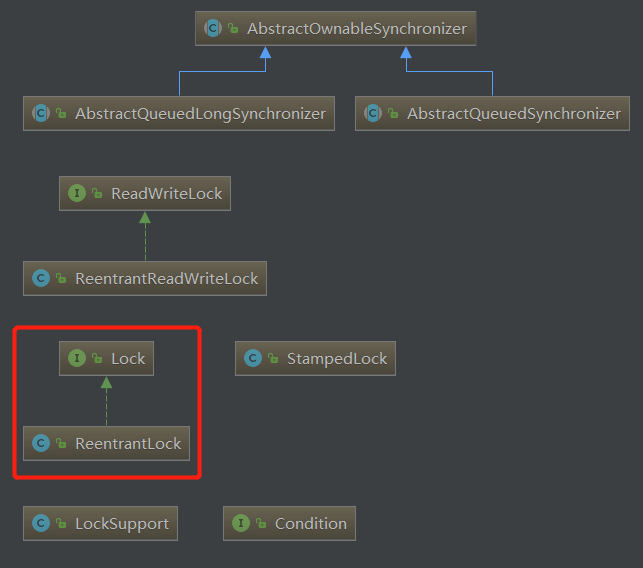【漫畫】JAVA併發程式設計 J.U.C Lock包之ReentrantLock互斥鎖
阿新 • • 發佈:2020-05-13
在如何解決原子性問題的最後,我們賣了個關子,互斥鎖不僅僅只有synchronized關鍵字,還可以用什麼來實現呢?
J.U.C包中還提供了一個叫做Locks的包,我好歹英語過了四級,聽名字我就能馬上大聲的說:Locks包必然也可以用作互斥!
# ReentrantLock
我們可以通過從具體到抽象的方法來揭開Locks包的神祕面試。

從圖中可以看出,有個叫做ReentrantLock實現了Lock介面,那麼就從它入手吧!
**顧名思義,ReentrantLock叫做可重入鎖,所謂可重入鎖,顧名思義,指的是執行緒可以重複獲取同一把鎖。**
**ReentrantLock也是互斥鎖,因此也可以保證原子性。**
先寫一個簡單的demo上手吧,就拿原子性問題中兩個執行緒分別做累加的demo為例,現在使用ReentrantLock來改寫:
```
private void add10K() {
// 獲取鎖
reentrantLock.lock();
try {
int idx = 0;
while (idx++ < 10000) {
count++;
}
} finally {
// 保證鎖能釋放
reentrantLock.unlock();
}
}
```
ReentrantLock在這裡可以達到和synchronized一樣的效果,為了方便你回憶,我再次把synchronized實現互斥的程式碼貼上來:
```
private synchronized void add10K(){
int start = 0;
while (start ++ < 10000){
this.count ++;
}
}
```
由於它倆都算互斥鎖,所以大家都喜歡拿它們做比較,我們來看看究竟有什麼區別吧
# ReentrantLock與synchronized的區別
**1、重入**
synchronized可重入,因為加鎖和解鎖自動進行,不必擔心最後是否釋放鎖;ReentrantLock也可重入,但加鎖和解鎖需要手動進行,且次數需一樣,否則其他執行緒無法獲得鎖。
**2、實現**
synchronized是JVM實現的、而ReentrantLock是JDK實現的。說白了就是,是作業系統來實現,還是使用者自己敲程式碼實現。
**3、效能**
在 Java 的 1.5 版本中,synchronized 效能不如 SDK 裡面的 Lock,但 1.6 版本之後,synchronized 做了很多優化,將效能追了上來。
**4、功能**
ReentrantLock鎖的細粒度和靈活度,都明顯優於synchronized ,畢竟越麻煩使用的東西肯定功能越多啦!
特有功能一:可指定是公平鎖還是非公平鎖,而synchronized只能是非公平鎖。
公平的意思是先等待的執行緒先獲取鎖。可以在建構函式中指定公平策略。
```
// 分別測試為true 和 為false的輸出。為true則輸出順序一定是A B C 但是為false的話有可能輸出A C B
private static final ReentrantLock reentrantLock = new ReentrantLock(true);
public static void main(String[] args) throws InterruptedException {
ReentrantLockDemo2 demo2 = new ReentrantLockDemo2();
Thread a = new Thread(() -> { test(); }, "A");
Thread b = new Thread(() -> { test(); }, "B");
Thread c = new Thread(() -> { test(); }, "C");
a.start();b.start();c.start();
}
public static void test() {
reentrantLock.lock();
try {
System.out.println("執行緒" + Thread.currentThread().getName());
} finally {
reentrantLock.unlock();//一定要釋放鎖
}
}
```
在原子性文章的最後,我們還賣了個關子,以轉賬為例,說明synchronized會導致死鎖的問題,即兩個執行緒你等我的鎖,我等你的鎖,兩方都阻塞,不會釋放!為了方便,我再次把程式碼貼上來:
```
static void transfer(Account source,Account target, int amt) throws InterruptedException {
// 鎖定轉出賬戶 Thread1鎖定了A Thread2鎖定了B
synchronized (source) {
Thread.sleep(1000);
log.info("持有鎖{} 等待鎖{}",source,target);
// 鎖定轉入賬戶 Thread1需要獲取到B,可是被Thread2鎖定了。Thread2需要獲取到A,可是被Thread1鎖定了。所以互相等待、死鎖
synchronized (target) {
if (source.getBalance() > amt) {
source.setBalance(source.getBalance() - amt);
target.setBalance(target.getBalance() + amt);
}
}
}
}
```
而ReentrantLock可以完美避免死鎖問題,因為它可以破壞死鎖四大必要條件之一的:不可搶佔條件。這得益於它這麼幾個功能:
特有功能二:非阻塞地獲取鎖。如果嘗試獲取鎖失敗,並不進入阻塞狀態,而是直接返回false,這時候執行緒不用阻塞等待,可以先去做其他事情。所以不會造成死鎖。
```
// 支援非阻塞獲取鎖的 API
boolean tryLock();
```
現在我們用ReentrantLock來改造一下死鎖程式碼
```
static void transfer(Account source, Account target, int amt) throws InterruptedException {
Boolean isContinue = true;
while (isContinue) {
if (source.getLock().tryLock()) {
log.info("{}已獲取鎖 time{}", source.getLock(),System.currentTimeMillis());
try {
if (target.getLock().tryLock()) {
log.info("{}已獲取鎖 time{}", target.getLock(),System.currentTimeMillis());
try {
log.info("開始轉賬操作");
source.setBalance(source.getBalance() - amt);
target.setBalance(target.getBalance() + amt);
log.info("結束轉賬操作 source{} target{}", source.getBalance(), target.getBalance());
isContinue=false;
} finally {
log.info("{}釋放鎖 time{}", target.getLock(),System.currentTimeMillis());
target.getLock().unlock();
}
}
} finally {
log.info("{}釋放鎖 time{}", source.getLock(),System.currentTimeMillis());
source.getLock().unlock();
}
}
}
}
```
tryLock還支援超時。呼叫tryLock時沒有獲取到鎖,會等待一段時間,如果執行緒在一段時間之內還是沒有獲取到鎖,不是進入阻塞狀態,而是throws InterruptedException,那這個執行緒也有機會釋放曾經持有的鎖,這樣也能破壞死鎖不可搶佔條件。
```boolean tryLock(long time, TimeUnit unit) ```
特有功能三:提供能夠中斷等待鎖的執行緒的機制
synchronized 的問題是,持有鎖 A 後,如果嘗試獲取鎖 B 失敗,那麼執行緒就進入阻塞狀態,一旦發生死鎖,就沒有任何機會來喚醒阻塞的執行緒。
但如果阻塞狀態的執行緒能夠響應中斷訊號,也就是說當我們給阻塞的執行緒傳送中斷訊號的時候,能夠喚醒它,那它就有機會釋放曾經持有的鎖 A。這樣就破壞了不可搶佔條件了。ReentrantLock可以用lockInterruptibly方法來實現。
```
public static void main(String[] args) throws InterruptedException {
ReentrantLockDemo5 demo2 = new ReentrantLockDemo5();
Thread th1 = new Thread(() -> {
try {
deadLock(reentrantLock1, reentrantLock2);
} catch (InterruptedException e) {
System.out.println("執行緒A被中斷");
}
}, "A");
Thread th2 = new Thread(() -> {
try {
deadLock(reentrantLock2, reentrantLock1);
} catch (InterruptedException e) {
System.out.println("執行緒B被中斷");
}
}, "B");
th1.start();
th2.start();
th1.interrupt();
}
public static void deadLock(Lock lock1, Lock lock2) throws InterruptedException {
lock1.lockInterruptibly(); //如果改成用lock那麼是會一直死鎖的
try {
Thread.sleep(1000);
} catch (InterruptedException e) {
e.printStackTrace();
}
lock2.lockInterruptibly();
try {
System.out.println("執行完成");
} finally {
lock1.unlock();
lock2.unlock();
}
}
```
特有功能四、可以用J.U.C包中的Condition實現分組喚醒需要等待的執行緒。而synchronized只能notify或者notifyAll。這裡涉及到執行緒之間的協作,在後續章節會詳細講解,敬請關注公眾號【胖滾豬學程式設計】。
文中程式碼github地址:
> 本文轉載自公眾號【胖滾豬學程式設計】 用漫畫讓程式設計so easy and interesting!歡迎關注!形象來源於微信表情包【胖滾家族】喜歡可以
